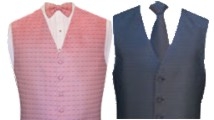Enhancing Your Look

Fashion borrows a lot from the flow of a river. It begins with a slow pace, then gains more momentum and water from tributaries. Styles also develop with time as they are modified for more appeal. Consider the waistcoat. It is a sleeveless upper-body garment worn over a dress shirt and necktie. It is also commonly identified as the third piece in a ‘three-piece’ male business suit.
It is an item whose presence makes or breaks a gentleman. Although it is said that ‘looks deceive,’ I beg to differ and alter it to ‘looks conceal deceit’. The waistcoat, initially worn to conceal huge tummies that interrupted the perpendicular alignment of the necktie to the belt, was a mandatory piece in contemporary dress in the English-speaking world. The men regarded the waistcoat as a tool that handled more than one function. Apart from the ‘concealing’ function, it helped resist wind-chill and light rain. Before wristwatches became popular, a gentleman would place his watch in the front pocket of his waistcoat, attached to one of the buttons with a watch-chain also called a fob. This practice remains acceptable, though uncommon.
When producing a three-piece suit, manufacturers would cut the waistcoat from the same material as the jacket and trousers. This meant that three-piece suits would cost more than the ordinary two piece suit. People who could not afford to purchase the three-piece suit, felt left out of the ‘gentleman’s style’. It is for this reason that sweater manufacturers started to produce sleeveless sweaters, better known as windbreakers, whose shape and function is almost similar to the waistcoat. One would thus buy an ordinary suit then purchase a windbreaker separately, a practice that most people adopted to conform to the trends. However, this did not render the waist coat obsolete; instead it became an icon for the economically endowed in the society. It became a symbol of power and wealth to adorn a ‘real’ three piece suit and not a ‘cloned’ one as was the case for those with windbreakers.
Waistcoats are popular throughout the world. Africa, being a generally humid region, adorning the waistcoat saves one from the over-sweating experienced by men and women who adorn jackets for the boardroom and other official duties. Costs aside, the waistcoat is an ideal tool to accentuate your official look without having to adorn a suit, because it is much appropriate to wear a waistcoat of a different colour from your trousers or skirt and still have an appealing look than adorning a ‘broken-suit’ that may not add up to an outfit of repute.
Contrasting waistcoats with the trousers or shirts can give a fresh look. Whenever adorning a waistcoat, the tie should match or be similar to the waistcoat if the shirt is lighter in colour. However, if the shirt’s colour is darker than that of the waistcoat, a white waistcoat, and a silver-grey tie will play a good bridging role to give an accentuated look that blends well with the dark African skin.
We therefore need to learn from the past to help us come up with better ideas for the future. In re-thinking the waistcoat/windbreaker idea, we should embrace its functions and avoid sweaty experiences during board meetings and other black-tie events in thick multi-layered suits.
